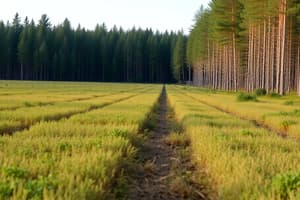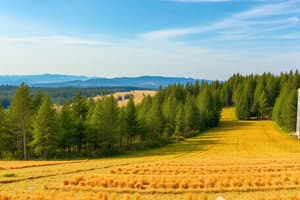Podcast
Questions and Answers
Which of the following factors is LEAST likely to influence the valuation of raw land, farmland, and timberland?
Which of the following factors is LEAST likely to influence the valuation of raw land, farmland, and timberland?
- Potential for generating income through leasing agreements.
- Prevailing interest rates set by central banking authorities. (correct)
- Quality of soil and access to essential water resources.
- Proximity to transportation networks and market accessibility.
What is a primary distinction between investing in farmland versus timberland, concerning the expertise and management structures available to investors?
What is a primary distinction between investing in farmland versus timberland, concerning the expertise and management structures available to investors?
- Timberland investments often involve Timberland Investment Management Organizations (TIMOs) for investors lacking direct expertise, a structure less commonly used in farmland investments. (correct)
- Farmland investments necessitate specialized expertise in agricultural commodity markets, while timberland investments do not require specific knowledge.
- Timberland investments are generally more accessible to retail investors through publicly traded partnerships, unlike farmland investments which require institutional expertise.
- Farmland investments are primarily managed through REITs, offering investors direct control over agricultural operations, contrasting with the passive nature of timberland investments.
Considering the various investment options in natural resources, which structure offers the MOST liquidity and accessibility for retail investors looking to invest in farmland?
Considering the various investment options in natural resources, which structure offers the MOST liquidity and accessibility for retail investors looking to invest in farmland?
- Direct investment in raw farmland, allowing for complete operational control.
- Limited partnerships that require substantial capital commitments and have restricted trading.
- Newer REITs (Real Estate Investment Trusts) specializing in farmland. (correct)
- Traditional bank loans or private debt used for financing farmland acquisitions.
How do agricultural crops and timber compare as investments that appeal to those focused on Environmental, Social, and Governance (ESG) factors, particularly climate change?
How do agricultural crops and timber compare as investments that appeal to those focused on Environmental, Social, and Governance (ESG) factors, particularly climate change?
Which factor MOST directly influences governmental decisions regarding subsidies for food crops or price support for farmers?
Which factor MOST directly influences governmental decisions regarding subsidies for food crops or price support for farmers?
Given the potential impacts of climate change-related regulations, which of the following outcomes is MOST plausible regarding the demand for various commodities?
Given the potential impacts of climate change-related regulations, which of the following outcomes is MOST plausible regarding the demand for various commodities?
Why are derivatives, such as futures, more commonly used to gain exposure to commodities compared to direct investment in the physical goods themselves?
Why are derivatives, such as futures, more commonly used to gain exposure to commodities compared to direct investment in the physical goods themselves?
What is a key advantage of investing in managed futures funds structured as publicly traded mutual funds compared to those structured as limited partnerships?
What is a key advantage of investing in managed futures funds structured as publicly traded mutual funds compared to those structured as limited partnerships?
How does the futures price of a commodity theoretically relate to its spot price, considering factors like storage costs and convenience yield?
How does the futures price of a commodity theoretically relate to its spot price, considering factors like storage costs and convenience yield?
What market condition is indicated when futures prices are significantly higher than spot prices, and how does this condition typically impact long-only commodity investors?
What market condition is indicated when futures prices are significantly higher than spot prices, and how does this condition typically impact long-only commodity investors?
What is the primary reason that the supply of many commodities is considered inelastic in the short run?
What is the primary reason that the supply of many commodities is considered inelastic in the short run?
How do weather patterns and plant diseases MOST commonly affect commodity prices, particularly those of agricultural commodities?
How do weather patterns and plant diseases MOST commonly affect commodity prices, particularly those of agricultural commodities?
What type of analysis do commodity producers typically undertake to estimate future production needs?
What type of analysis do commodity producers typically undertake to estimate future production needs?
Historically, how have commodity returns correlated with the returns of global equities and bonds, and what implication does this have for portfolio diversification?
Historically, how have commodity returns correlated with the returns of global equities and bonds, and what implication does this have for portfolio diversification?
Under what inflationary conditions do commodities typically outperform both stocks and bonds, and why?
Under what inflationary conditions do commodities typically outperform both stocks and bonds, and why?
Which of the following risk factors has the MOST pronounced impact on commodity prices?
Which of the following risk factors has the MOST pronounced impact on commodity prices?
How does the choice of when to harvest timber compare to harvesting most agricultural crops, in terms of decision-making factors?
How does the choice of when to harvest timber compare to harvesting most agricultural crops, in terms of decision-making factors?
What is the primary economic implication of 'convenience yield' exceeding storage costs in commodity markets?
What is the primary economic implication of 'convenience yield' exceeding storage costs in commodity markets?
What role do inventory levels play in forecasting commodity prices, according to analysts?
What role do inventory levels play in forecasting commodity prices, according to analysts?
What is a Separately Managed Account (SMA) and for what type of investors are SMAs most appropriate?
What is a Separately Managed Account (SMA) and for what type of investors are SMAs most appropriate?
Flashcards
Natural Resources
Natural Resources
Raw land, land for crops/timber, and commodities, investable directly or via funds/derivatives.
Raw Land, Farmland, Timberland
Raw Land, Farmland, Timberland
Illiquid investments, value driven by location, generating lease income and price appreciation.
Farmland Holders
Farmland Holders
Individuals are primary holders, while Institutions typically invest.
Commodity Sectors
Commodity Sectors
Signup and view all the flashcards
Commodity Derivatives
Commodity Derivatives
Signup and view all the flashcards
ETPs (Exchange-Traded Products)
ETPs (Exchange-Traded Products)
Signup and view all the flashcards
Managed Futures Funds
Managed Futures Funds
Signup and view all the flashcards
Convenience Yield
Convenience Yield
Signup and view all the flashcards
Contango
Contango
Signup and view all the flashcards
Backwardation
Backwardation
Signup and view all the flashcards
Spot Prices
Spot Prices
Signup and view all the flashcards
Commodity Benefits
Commodity Benefits
Signup and view all the flashcards
Study Notes
- Natural resources include raw land, land for crops/timber, and commodities.
- Natural resource investment can be direct or through funds like ETFs and REITs.
- Derivatives such as commodity futures provide exposure to this asset class.
- Raw land, farmland, and timberland are illiquid with value driven by location.
- Proximity to transportation, markets, water access, and soil quality enhance the value of farmland and timberland.
- Farmland and timberland generate lease income, price appreciation, and income from output.
- Individuals primarily hold farmland, while institutions invest in raw land and timberland.
- Timberland lots are larger than farmland and require specialized expertise.
- TIMOs allow investors without expertise to invest in timberland.
- Farmland and timberland have fewer financing options compared to residential or commercial real estate.
- Financing often comes as bank loans or private debt.
- Farmland REITs enable retail investors to invest in this category.
- Timber harvesting decisions are based on prices and growth rates.
- Farmers use commodity futures to hedge harvests.
- Agricultural crops consume carbon, appealing to ESG investors focused on climate change.
Commodities
- Commodities are divided into metals, agricultural products, and energy products.
- Commodity contracts are classified by grade and delivery location.
- Governments may subsidize food crops or control natural resource access.
- Climate change regulations may decrease demand for fossil fuels and increase demand for lithium, cobalt, and nickel.
- Futures are more commonly used than direct investment in commodities.
- Physical commodities incur storage and transportation costs.
- Futures, forwards, and options on futures are available commodity derivatives.
- Futures trade on exchanges, eliminating counterparty risk.
Methods of Commodity Exposure
- ETPs (ETFs or ETNs) allow investors limited to equity shares to invest in commodities.
- ETFs invest in commodities or commodity futures and track prices or indexes.
- Managed futures funds (CTAs) are actively managed, focusing on specific or diverse sectors.
- Managed futures funds can be limited partnerships or mutual funds, offering different accessibility and liquidity.
- SMAs are for larger investors needing custom portfolios.
Commodity Valuation
- Wheat today differs from wheat in six months due to storage costs and immediate usability.
- Formula: futures price ≈ spot price × (1 + risk-free rate) + storage costs - convenience yield
- Convenience yield is the nonmonetary value of having a physical commodity for use over the futures contract period.
- Contango occurs when futures prices are higher than spot prices due to low convenience yield.
- Backwardation occurs when futures prices are lower than spot prices due to high convenience yield.
- Contango decreases returns for long-only investors, while backwardation increases them.
Commodity Prices and Investments
- Spot prices are a function of supply and demand.
- Demand is affected by the value of the commodity to end users and global economic conditions.
- Supply is affected by production, storage costs, and existing inventories.
- Supply is inelastic in the short run due to long lead times.
- Commodity prices can be volatile due to demand changes or supply shocks.
- Weather and plant disease affect agricultural commodity production.
- Costs of extracting oil and minerals increase with difficult methods or locations.
- Commodity producers analyze economic events, government policy, and supply forecasts.
- Investors analyze inventory levels, production forecasts, policy changes, and economic growth expectations.
- Commodity returns and volatility have been higher than global stocks or bonds in recent decades.
- Timberland and farmland have higher average returns but lower volatility than global stocks, similar to global bonds.
- Speculators can earn high returns with accurate expectations about short-term commodity price movements.
- Commodity returns have historically low correlations with global equities and bonds.
- Adding commodities to a traditional portfolio provides diversification benefits.
- Holding commodities can hedge inflation risk.
- Commodities outperform (underperform) stocks and bonds during high (low) inflation.
- Commodity prices are more sensitive to geopolitical and weather-related risk factors.
Studying That Suits You
Use AI to generate personalized quizzes and flashcards to suit your learning preferences.



